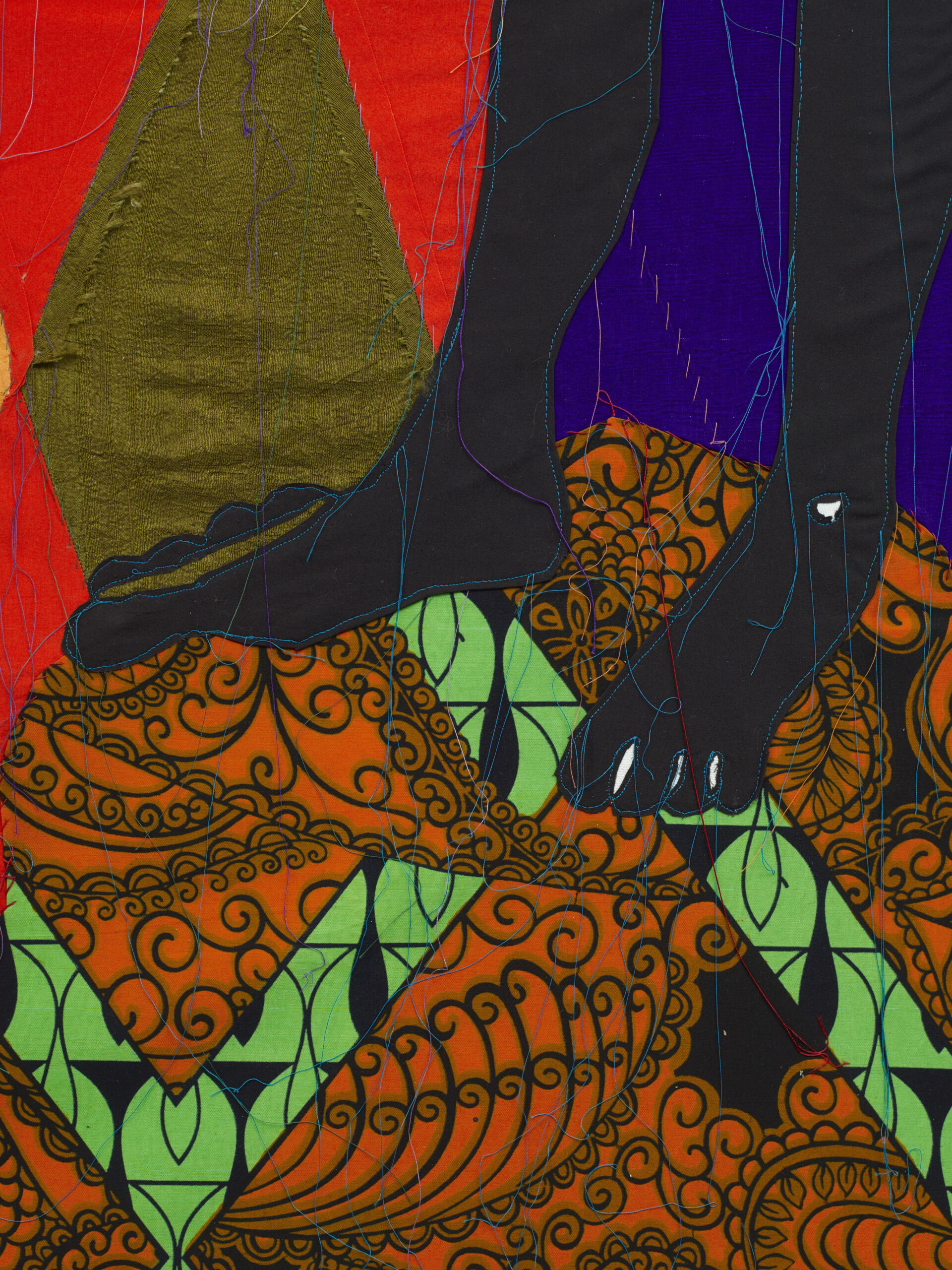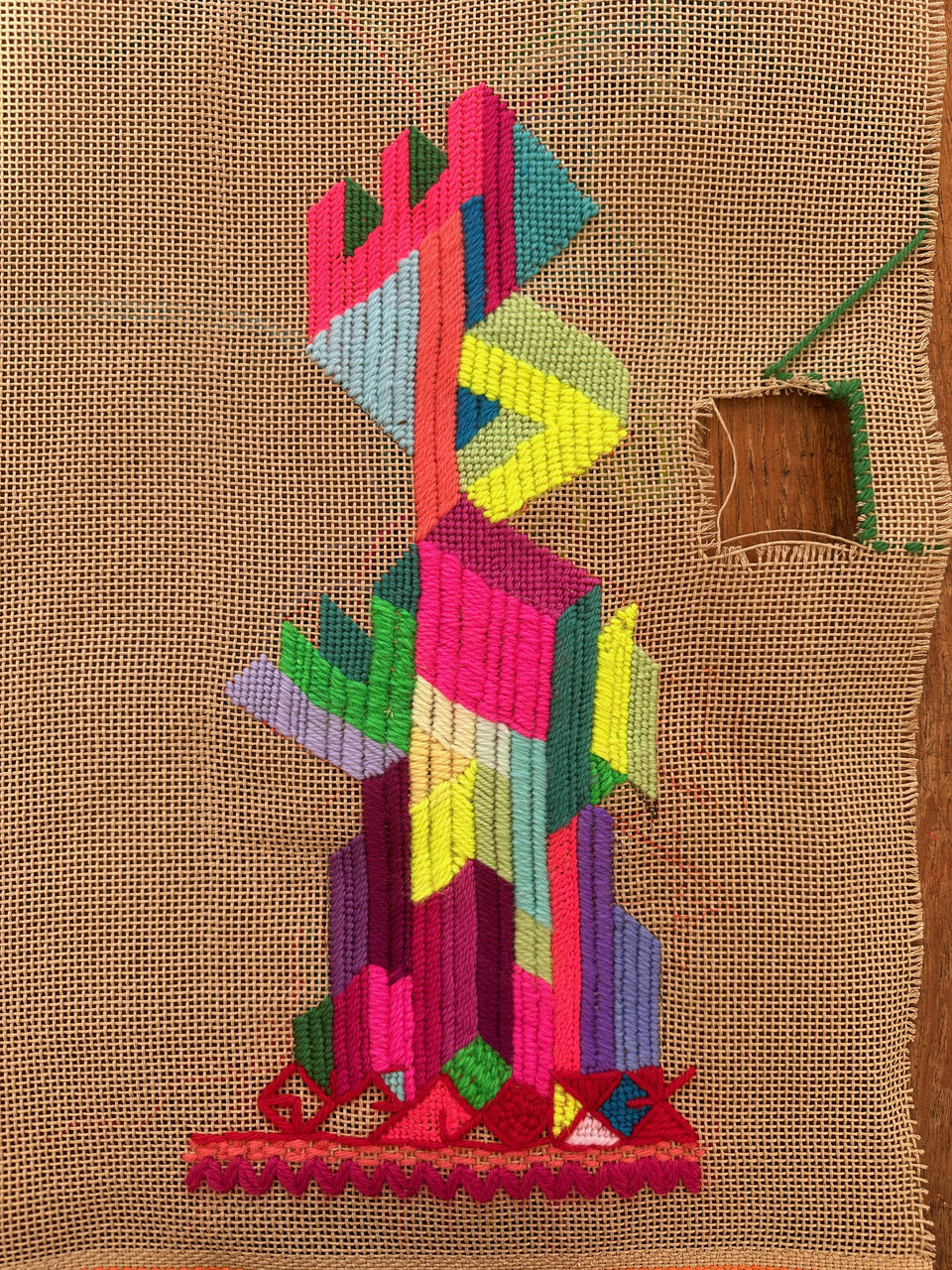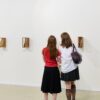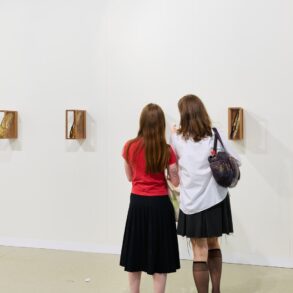How can a piece of embroidery made using a simple needle and thread create a piece of toast that looks crunchy, a slice of orange that looks juicy or a bowl of noodles that looks slurpy? At a glance it would be easy to mistake Youmeng Liu’s embroidered 3D sculpture of a fried egg on toast for the real thing. If anything, Liu’s textile rendering of the egg looks crispier at the edges, the toast perfectly browned.
The Chinese-born, Bristol-based embroidery artist caused a sensation recently in Venice when she demonstrated the unique punch needlecraft technique she discovered on a trip home to Kunming in southwest China in 2010. Collectors and fans who follow her work on social media watched in astonishment as she embroidered a three-dimensional slice of cake, conjuring the fragrant strawberries, the whipped cream, the soft golden sponge. They are everyday items of food, but in Liu’s hands they become fantastical works of art. If she works eight hours a day, a single cauliflower floret will take three to five days to complete. But fans have become so enthused with her work that she has created kits that she sells on her website, embroiderycode.com, and started online courses on Domestika.
She is not the only crafter using needlework in their art. The Hayward Gallery Touring’s Material Worlds exhibition features 15 artists exploring the cultural history of textiles including Yinka Shonibare’s Creatures of the Mappa Mundi — Epiphagi, using a rich mix of patchwork, appliqué, embroidery and Dutch wax printed cotton. In 2023, the Arnolfini in Bristol hosted Threads, which featured 21 textile artists and was co-curated by the embroidery artist Alice Kettle, whose own work includes painterly portraits — all stitched. And in October the V&A acquired a series of six hand-embroidered hoops by the London-based Lebanese-British textile artist Aya Haidar, which will go on display at the V&A’s Jameel Gallery early next year.

A detail from Yinka Shonibare’s Creatures of the Mappa Mundi — Epiphagi
STEPHEN WHITE & CO
At the Sunbury Embroidery Gallery in Surrey, Kate Wells’s ethereal embroidered landscapes of north Norfolk are the centrepiece of her present solo show, Land, Sky and Gold. The work started as a commission to make a special birthday present depicting a family’s holiday location near Holkham Hall and Estate in Norfolk. Wells, who has been embroidering landscapes since the late Seventies, started with a photograph and a map, then visited the area. Armed with sketches, notes and photographs, she started with gouache and acrylic, “working up skies, dunes and birds”, before finally using stitch to turn “the energy of the brushwork into lines and textures of free embroidery”.
Wells translates her paintings and sketches to stitch using a 1930s Singer “Irish” sewing machine — with a knee lever that allows her to adjust the width of her zigzag stitches, leaving her hands free to guide her work — with just the same freshness and spontaneity as a pencil or paintbrush. “The rest is just experience and daring,” she says.
Advertisement
This ability to “paint” with needle and thread demonstrates that embroidery “can be just as expressive and intricate as any traditional art form”, says Michiko Gardner, head of the Sunbury Embroidery Gallery. She has noticed that far more people are interested in embroidery since the pandemic, citing a growing recognition of the skill and creativity involved, the mental health benefits and a broader art-world trend towards re-evaluating underappreciated art forms. “The association of stitching with women has historically led to its undervaluation, despite the incredible skill, creativity and, often, fine-art training required to ‘paint’ with needle and thread,” she says.
The artist Morag Myerscough recently rediscovered the medium, having loved to sew as a child. Her mother, the textile artist Betty Fraser Myerscough, was of the generation whose embroidery would have been dismissed by the serious art fraternity. She taught embroidery at Gray’s School of Art, Aberdeen, and was part of the influential 62 Group of Textile Artists.

Love and Unity by Morag Myerscough
As a child, Myerscough was obsessed with sewing. Wanting to see “if I still had that thought process over 40 years later”, she started to stitch the flowers in her garden. In November, she was part of a community-based project called Love & Unity during the Doncaster Festival of Light, using embroidered panels to create physical structures with her signature abstract patterns and words. “The multitude of colours is phenomenal,” she says. “It’s very similar to using paint.”
There is a real appetite for textiles in art, as Kate Jenkins recently discovered with her solo show at the Air Contemporary gallery in Ham Yard in central London. She recreated a fishmonger’s counter in crochet, knit and thread, complete with sequinned prawns and stitched sardines. Passers-by were amused to find they could order their own embroidered seafood platter from the fish counter. Jamie Oliver bought two framed works, including a pair of sardines on a plate. Ham Yard Hotel bought a large stitched seafood assortment. “In a screen-obsessed digital age I think people do like to turn away from the constant scrolling on phones and see something that’s 3D and engaging,” Jenkins says.
• Meet the next generation of needleworkers
Advertisement
For Nadia Albertini, an embroidery practitioner and historian who has worked for fashion houses including Chloé, Chanel and Dries Van Noten, it’s the disconnection with the material world that is bringing the need for “just a little bit of shimmer” to people’s lives, whatever their budget. She is working on a range of couture cushions that are lavishly embroidered and deliciously tactile, as well as panels for interiors and embroidered furniture for the next Salon de Révélations, the international biennial exhibition of arts and crafts at the Grand Palais in Paris next May. “I’m fine-tuning techniques to be very sophisticated, very beautiful, but still adapted to daily use at home,” she says.

Embroidery by Kate Wells on a chair back
Albertini grew up in Mexico City with her grandmother, who spent her time embroidering cushions. “It’s how I speak and how I say things,” she says. “Marking your clothes with thread comes from the cavemen. They were doing this before they even knew how to talk.” For anyone wanting to learn this language, Albertini hosts what she describes as “stitching adventures”, where she takes small groups on trips to Tuscany to an embroidery retreat or, in February, to India visiting the best craftspeople in Mumbai, Jaipur and Calcutta. In June, she is taking a group to southern Italy, working with a local farm creating silk yarn, dyeing it naturally and learning to embroider with it.
Closer to home in east London, the London Embroidery Studio is hidden away under a railway arch in Haggerston. Inside, it’s a high-tech laboratory of stitching, the first studio in the UK to offer a creative, playful use of machine embroidery. Its founder, Andy Petty, who studied textiles at Goldsmiths, started out 20 years ago from a friend’s garage, working on a Singer “Irish” machine like the one Wells uses. “You can make a zigzag if you put pressure on the pedal on your knee, so you can draw with it, which is really beautiful,” Petty says. He also recently invested in a state-of-the-art digital machine (costing £85,000) which can, he says, create the same subtlety and more.
• The Van Goghs of the embroidery world
For the 2023 Oscars, the London Embroidery Studio created seven large-scale tapestries celebrating female directors, which were exhibited at the Women in Film event and the Vanity Fair party. In 2018 it stitched the BBC World Cup animation, bringing a whole different aesthetic to the sport. And Ridley Scott’s epic Napoleon is worth watching for the embroideries alone (all made in Haggerston using polyester thread because Joaquin Phoenix’s strict vegan policy for costumes and sets ruled out silk), from uniforms to saddle blankets, flags and thrones.
Advertisement
This is embroidery’s cutting edge and it’s being applied to everything from art (a recent commission for Chris Offili for the Fondazione Prada), fashion (Dior is a regular client) and film to interiors for private jets, yachts, even the bespoke customisation of an Aston Martin Vanquish.
Petty thinks Grayson Perry winning the Turner prize in 2003 was a turning point. “In the UK 20 years ago, fine art was painting or sculpture, and that was it, whereas now people are quite happy to see a bit more craftsmanship, fabric and texture, ceramics as well as textiles,” he says. “I think it’s really changed.”
embroiderycode.com; candidastevens.com; southbankcentre.co.uk; ayahaidar.com; sunburygallery.org; katewellsartist.co.uk; moragmyerscough.com; rightupourstreet.org.uk; katejenkinsstudio.co.uk; nadiaembroidery.com; londonembroiderystudio.com
This post was originally published on this site be sure to check out more of their content








